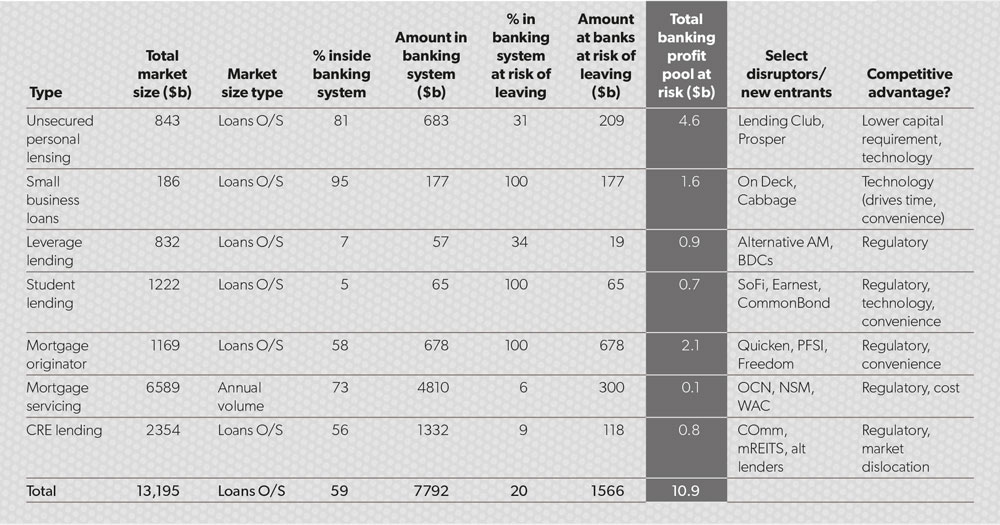Peer-to-peer investing can be a powerful tool for SMSFs. But Chris Andrews explains fundamentals of good investment decision-making still apply.
Peer-to-peer (P2P) investment looks like it is here to stay. Its potential as a source of higher yields for SMSF members over bank deposits means it can be a powerful yield enhancement tool. The unique flexibility associated with P2P makes it attractive to borrowers and investors alike. Table 1 shows the opportunities open to investors in the international P2P markets.
However, this does not mean investors should forget the tried and tested rules of investment when they look at the P2P sector. From the discussions around P2P, an investor could be forgiven for getting lost in issues of disruption and innovation, of banks and fintech. But when you as an SMSF trustee or adviser consider an allocation to P2P, the fundamental principles still apply. At the most basic level, just like any asset class or segment, P2P investment performance will continue to be driven by the underlying assets selected and the investment structure, all underpinned by the expertise of the P2P manager.
It’s asset management, not a tech play
In 1992, political strategist James Carville posted a sign on the wall of then-governor of Arkansas Bill Clinton’s presidential campaign headquarters in Little Rock, Arkansas, that said: “It’s the economy, stupid.” It became the emblematic slogan of Clinton’s ultimately successful campaign to unseat sitting president George HW Bush less than two years after Bush’s 90 per cent post-Gulf War approval ratings.
Applying this thinking to P2P investments, SMSF investors could do worse than adopt a similar mantra: “It’s the assets, stupid.” Frankly, much of the coverage to date about P2P completely misses the point. We hear about fintech hubs, regulatory reform and cloud-based innovation, but P2P investors are not investing in technology companies, they are investing in assets that are originated and managed by managers.
Investment outcomes for P2P investors will therefore depend on how well those assets perform and not by the bells and whistles of the manager’s IT platforms. It makes sense then that the first question for a prospective P2P investor should be about what assets are being targeted.
Earlier this year, La Trobe Financial undertook a survey of the 16 leading Australian operators/managers in the P2P lending space.
Overwhelmingly these managers specialised in unsecured personal or business loans. These segments of the credit market offer higher yields, but also higher risk. Security is a key and pressing issue for investors, particularly those at or near retirement who work on capital preservation during the de-accumulation phase of their SMSF.
Investors need to be sure they are comfortable with the risk/return profile, not only of the segment of the asset class their manager is targeting, but also with the manager’s individual strategy within that segment. As with any manager, track record is critical here. Some of the hype around parts of the P2P sector has focused on the returns big banks have been able to generate in areas such as personal credit. However, there is no guarantee a new entrant, with substantially less management resources on which to draw, will be able to replicate this performance.
Ultimately, the performance of the assets of a P2P manager is likely to depend on two key issues: the rigour of the manager’s credit assessment and the manager’s strength in collecting outstanding loans. The discussion around P2P has generally covered credit assessment in a superficial way. Many of the P2P entrants have touted their ability to assess loan applications on the basis of an internal predictive algorithm or quasi-rating of an applicant. Others have talked about the introduction of comprehensive credit reporting (CCR) to Australia as a fundamental enabler of the P2P model. Recently, the Australian Securities and Investments Commission (ASIC) obtained an enforceable undertaking from a small payday lender, Nimble, to refund borrowers over $1.5 million because the regulator believed it failed to meet its responsible lending obligations by using an algorithm that didn’t allow for certain risk factors, including not taking consumer financial information into account.
This is most important as current internal ratings and algorithms are broadly untested for any economic downturn and have not demonstrated predictive value. They are a reflection of the manager’s own expertise, or lack thereof, in the asset class. In the absence of an externally-validated track record, they are of little use in an investment decision by an external investor.
In addition, the use of external credit bureau reports is limited. CCR envisages lenders providing more data to credit reporting agencies, including positive data extending beyond the previous regime of negative reporting of payment defaults and the like. The objective is to enhance the predictive value of credit reporting, replicating the experience of markets such as the United States, where comprehensive credit reporting is standard and outputs such as FICO scores are widely-used elements of a credit assessment.
Unfortunately, the Australian industry take up of CCR has been disappointing. As at March 2016, just nine lenders had signed on to provide the richer data sets underpinning the system. While useful, CCR is only one part of a credit assessment and is not a substitute for well-documented, disciplined and rigorous credit assessment processes. It is yet to be seen whether the new P2P managers can achieve this standard.
If discussion of credit assessment has been superficial, discussion of collections capabilities among P2P managers has been non-existent. Where there are loans, there will be defaults on loans. Indeed, collections capability is frequently the key determinant of a loan portfolio’s performance. After all, anyone can lend money, but it’s getting the money back that’s the challenge.
All of this discussion comes back to the fundamental drivers of investment returns. Can the manager originate quality assets and manage them appropriately? What processes and disciplines does the manager have in place to manage risk? And, most fundamentally, are investors being appropriately rewarded for the risks to which they are exposing themselves? One high-profile P2P lender outsources this role entirely to a third-party collection house because it does not have sufficient staff resources itself.
The thinking behind investment structures
While perhaps not as obvious to many SMSF investors as asset selection, the manager’s legal investment structure is also a fundamental issue in the P2P sector. Much of the discussion in the media has revolved around the regulatory changes that are apparently essential if the sector is to flourish.
The Corporations Act 2001 provides for a range of fundraising vehicles that P2P managers can use to manage P2P loans, the gold standard of which is arguably the registered managed investment scheme. This structure has underpinned P2P and predecessor investments for many years. Its key features include the appointment of a public company with at least three directors as responsible entity, the lodgement of a constitution and compliance plan with ASIC, the issue of a product disclosure statement, licensing requirements for the fund manager and the requirement of the fund, trust or scheme to hold net assets of at least $10 million. The provisions in the act are primarily to protect the investor and the best interests.
Let’s not lose sight of the importance of striking an appropriate balance between regulatory efficiency and consumer protection. Both are fundamental if the P2P industry is to flourish.
Investors should also be sure they understand the specific investment structure of the manager. While many managers have been quick to jump on the P2P bandwagon, very few actually allow investors to select the individual assets in which they are investing. Just five of the 16 managers reviewed in the La Trobe Financial survey offered this functionality. The remainder offered either pooled portfolios – still valid investments in their own right, but not strictly P2P – or were not open to non-institutional investors at all. The genuine P2P manager is actually quite rare.
Table 1: International P2P market opportunities
Source: Goldman Sachs Global Investment Research estimates.
Manager expertise continues to be the key
Finally, when all is said and done, manager expertise or track record lies behind all P2P success. Quality managers will originate appropriate investment opportunities within the selected segment of the credit asset class. They will have rigorous and disciplined credit assessment/investment strategies. They will offer investors appropriate levels of choice in their investment settings in the context of a solid and transparent investment structure. They will have the resources and systems in place to ensure individual assets are managed across the whole-of-loan life cycle.
As with all investments, track record continues to be the key. Look for managers who provide regular and comprehensive reporting on their portfolios and whose results support their sales pitch. As the investor, you have the right to review this information before making your investment decision.
Oils ain’t oils
The most important message to remember is that each P2P manager has to be rigorously assessed against its track record and expertise – just as you’d expect of any manager. You’ll find the good, the bad, and the ugly among them, just as you would expect in any asset class.
La Trobe Financial’s $300 million P2P offering has been available to retail (including SMSF) investors for over two decades. Our strategy is to target first mortgage secured loans, paying premium yields with a maximum loan-to-value ratio of 75 per cent to ensure strong asset backing.
We have over 60 years of asset class experience and industrial strength credit assessment and collections processes that have managed over $10 billion cumulatively in institutional and retail portfolios without loss of a cent of investor capital or interest. We have over $100 million in net group assets.
We offer both market-leading pooled and single-asset investment structures with a minimum investment amount of just $1000. We do so in the context of a registered managed investment scheme and provide comprehensive reporting on a monthly basis.
We remain deeply committed to the P2P sector and have observed over many years the powerful results it can produce for SMSF investors. As long as advisers and investors maintain the disciplines around their investment decisions, we see no reason why this sector cannot continue to flourish in the years ahead.




